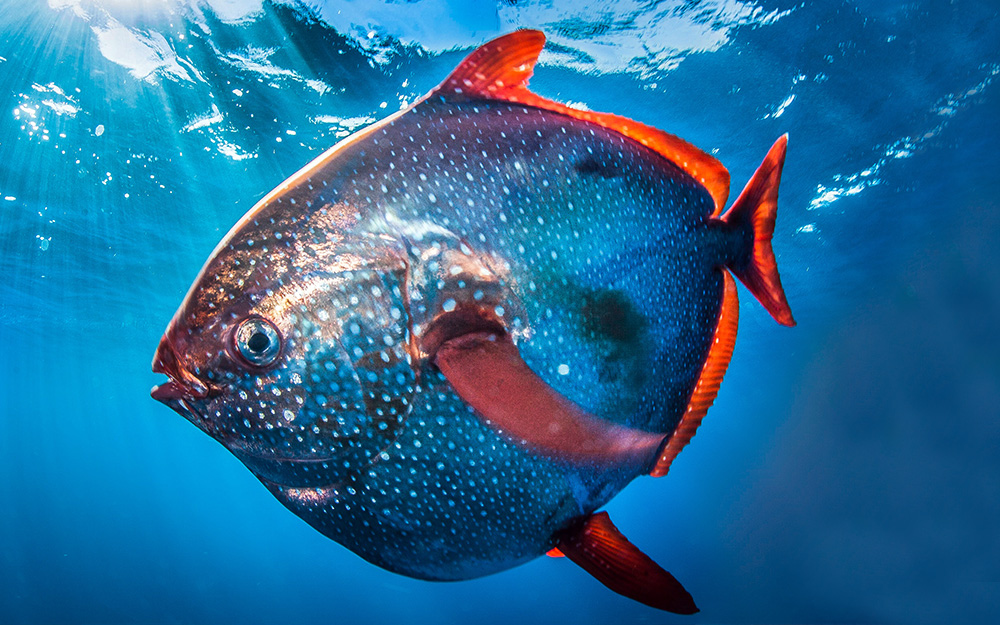North Atlantic opah
(Lampris guttatus)

Classification
General data
Lampris guttatus (Brünnich, 1788) North Atlantic opah – formerly thought to be cosmopolitan, but now thought to be restricted to the northeastern Atlantic including the Mediterranean Sea.
Commonly known as the opah, cravo, moonfish, kingfish, and Jerusalem haddock, is a large, colorful, deep-bodied pelagic lampriform fish belonging to the family Lampridae, which comprises the genus Lampris.
It is a pelagic fish with a worldwide distribution. While it is common to locations such as Hawaii and west Africa, it remains uncommon in others, including the Mediterranean. In the places where L. guttatus is prevalent, it is not a target of fishing, though it does represent an important commercial component of bycatch. It is common in restaurants in Hawaii. In Hawaiian longline fisheries, it is generally caught in deep nets targeting bigeye tuna. In 2005, the fish caught numbered 13,332. In areas where the fish is uncommon, such as the Mediterranean, its prevalence is increasing. Some researchers believe this a result of climate change. Much is still unknown about the distribution, interactions, life histories, and preferred habitats of this fish and other medium to large-sized pelagic fishes.
Description
Lampris guttatus is a large discoid and deeply keeled fish with an attractive form and a conspicuous coloration.
They can reach a maximum length of 2 m (6.6 ft) and a maximum weight of 270 kg (600 lb).
The body is a deep steely blue grading to rosy on the belly, with white spots in irregular rows covering the flanks. Both the median and paired fins are a bright vermillion. Jaws are vermillion, too. The large eyes stand out as well, ringed with golden yellow. The body is covered in minute cycloid scales and its silvery, iridescent guanine coating is easily abraded.
They have long falcated pectoral fins inserted (more or less) horizontally. The caudal fins are broadly lunated, forked, and emarginated. The pelvic fins are similar but a little longer than pectoral fins, with about 14–17 rays. The anterior portion of a dorsal fin (with about 50–55 rays) is greatly elongated, also in a falcate profile similar to the pelvic fins. The anal fin (34–41 rays) is about as high and as long as the shorter portion of the dorsal fin, and both fins have corresponding grooves into which they can be depressed. The snout is pointed and the mouth small, toothless, and terminal. The lateral line forms a high arch over the pectoral fins before sweeping down to the caudal peduncle.
Endothermy
In May 2015, L. guttatus was shown to maintain its entire body core above ambient temperature, becoming the first known fish with this trait (whole-body endothermy). The fish generates heat as well as propulsion with continuous movements of its pectoral fins (the musculature of which is insulated by a one-cm-thick layer of fat), and the vasculature of its gill tissue is arranged to conserve heat by a process of countercurrent heat exchange, a structure known as a rete mirabile (plural, retia).
It can consistently keep its body core approximately 5 °C warmer than its environment. Elevated body core temperature should improve aerobic performance and physiologic function. Other adaptions of L. guttatus to increase aerobic performance include high hematocrit and a relatively large heart, gill surface area and aerobic muscle mass. These adaptations for high performance predation are similar to those found in tuna and lamnid sharks, which actively chase down their prey, but are very unusual among lampridiform fish, which are mostly sluggish ambush predators.
Previously, L. guttatus was known to exhibit cranial endothermy, generating and maintaining metabolic heat in the cranial and optic regions to keep them 2 °C warmer than the rest of the body. This adaptation is important for maintaining brain and eye function during the wide range of temperatures it experiences with its vertical movements.
Most fish are completely cold-blooded. Some, such as tuna and lamnid sharks (such as the salmon shark), have evolved regional endothermy, in which parts of the body core are kept at a warmer temperature. These fish have retia arranged to warm muscles used for propulsion, and some visceral organs, while other organs, such as the heart, remain cooler. Only L. guttatus is known to have retia within its gill arches (which are also insulated by fat), an arrangement that warms the entire body core including the heart.











